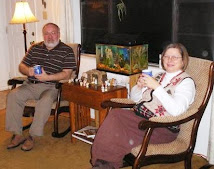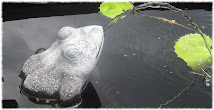
Our niece, Pam, and her friend, Becky, recently went on vacation in Hawaii. Knowing how I love Japanese, they sent me this picture of a Subway menu in Japanese. Becky pointed out that BLT is in English. What is fascinating is that about 80% of this menu is in English adapted into the Japanese language phonetically. It's something we might call Nihonglish (Nihongo is Japanese for the Japanese language). By learning a 46-character syllabary called Katakana, you could read 80% or more of this menu.
There are only a few actual Kanji (Chinese characters used to write Japanese) on the menu, and since they mostly use the On-yomi (that is the Chinese reading of the Kanji), they represent Chinese sounds/ideas adopted into Japanese.
In fact, the only real native Japanese on this menu, in one sense, are the few Hiragana (another 46-character syllabary, used to write native Japanese words and to add grammatical endings to the Kanji) along with a couple of Kanji using the Kun-yomi (Japanese reading of the character)!

Top Line says "Sabuay"-wa furesshu de Shinsen dakara itsumo oishii!" Subway fresh. Because it's fresh, it's always delicious). The two Kanji are read Shinsen, a second way to write the meaning "fresh."

Second line: "Okisa-wa 6 inchi to 12 inchi, rappu mo arimasu."—Sizes we have: 6-inch and 12-inch, and also wraps.


Top Line says "Sabuay"-wa furesshu de Shinsen dakara itsumo oishii!" Subway fresh. Because it's fresh, it's always delicious). The two Kanji are read Shinsen, a second way to write the meaning "fresh."

Second line: "Okisa-wa 6 inchi to 12 inchi, rappu mo arimasu."—Sizes we have: 6-inch and 12-inch, and also wraps.


Third line: "Yasai-wa oSukinamono o oErabi Kudasai." Literally (Regarding) vegetables (polite prefix) favorites or choices (polite prefix) choose please (humble word)—Choose the vegetables you would like. The prefix "o" added to the beginning of Sukinamono and Erabi is an example of word beautification and makes the language more polite. The word Kudasai is a form of please that shows humility on the part of the speaker (writer). When written as a Kanji, it points downward, as follows:
* Beji Deraito (Yasai to cheezu)"—Vegi Delight (Vegetables and Cheese)

* Tahkee Buresto (Shichimencho Muneniku)—Turkey Breast (Turkey Breast, but the word Shichimencho is interesting. It is the designation for a Turkey, but literally it means something like "Seven-Faced Bird," perhaps in reference to the various colors reflected by the turkey’s wattle.)
See more discussion of the word turkey in various languages on my blog here.
* Roesto Bifu —Roast Beef
* Sheefudo to Kurabu (Sheefudo to Kanikama) — Seafood and Fake Crab
* BLT (Baykon, Retasu, tomahto)—BLT (Bacon, Lettuce, Tomato)
* Hamu—Ham
* Roesto Chiken Buresto—Roast Chicken Breast
* Sabuay Kurabu (Tahkee, Roesto Beefu, Hamu)—Subway Club (Turkey, Roast Beef, Ham) (Notice crab and club are both transliterated the same into Katakana.)
* Itarian BMT (Peparoni, Sarami, Hamu)—Italian BMT (Pepperoni, Salami, Ham)
The BMT was supposedly originally named after the "Brooklyn-Manhattan Transit," but now is called Biggest, Meatiest, Tastiest.
* Tsuna (Tuna—this is the closest we can get in transliterating Tuna into Katakana).

* Teriyaki chiken—Teriyaki chicken
* Korudo Kahto Conbi (Hamu, Buroeni, Sarami)—Cold Cut Combi(nation) (Ham, Balogna, Salami)
* Chiken, Baykon Ranchi (Chiken, Baykon, Yasai)—Chicken Bacon Ranch (Chicken, Bacon, Ranch) (Note here that the word Lunch would also be transliterated Ranchi.)
* Steiki to Chizu—Steak and Cheese
* Pasutorami—Pastrami
* Beji Maxu (Yasai Hahmbahgah)—Vejimax (Vegetable Hamburger)

* Kizzu Paku (Kora Paku)—(Hamu, Tsuna, Softo Durinku, Tahkee something and it fades out-can't make out the characters, Durinku, and more unreadables)--Kid's Pack (Children's Pack) (Ham, Tuna, Soft Drink, Turkey, ........, Drink,....

* Kizzu Paku (Kora Paku)—(Hamu, Tsuna, Softo Durinku, Tahkee something and it fades out-can't make out the characters, Durinku, and more unreadables)--Kid's Pack (Children's Pack) (Ham, Tuna, Soft Drink, Turkey, ........, Drink,....

* Onomimono: Softo Durinku (Okii, Chui, Chiisai) Kara oErabi Kudasai, Gyunyu, Uroncha, Kocha mo Arimasu—Beverages: Soft Drinks (Large, Medium, Small) Choose, We also have Milk, Oolong Tea, and Black Tea.
* Supu: Kuramuchyaudah, Burokkari Chizu, Chiken Nudoru, Bifu Vejitaburu—Soup: Clam Chowder, Broccoli-Cheese, Chicken Noodle, Beef Vegetable
The Black Circle in the upper righthand corner says that you can add Bacon for 50 cents to the 6-inch or a dollar to the 12-inch sandwich.
This was also posted on Bonnie's Beans Blog here, with some additional Japanese language information.


































2 comments:
WONDERFUL! Glad you had fun with the menu!
I just commented on the beans blog. Don't know if you'll get notified of that comment but I wanted to come and leave a comment here too ! I know how I love having comments on my blog ! Anyway ... it's wonderful ! I can hear you explaining all of these things in my mind ! It make me smile to 'listen' !! Love you !! Bon
Post a Comment